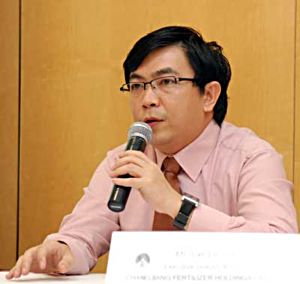
FERTILIZER PRODUCER, Changjiang Fertilizer, which started trading on the SGX yesterday after a backdoor listing, wants to expand by buying other fertilizer players.
The company had placed out 23.5% of its issued capital at 29 cents per share, raising S$24.5 million.
The fertilizer production market is a highly fragmented one, with numerous small to mid-sized players up for grabs, according to the company’s executive chairman and CEO, Mr Zhu Cheng Bao.
And it is much cheaper to expand capacity by M&A, compared to building a brand new plant from scratch, he said.
For example, a new facility with annual capacity of 10,000 tons of anhydrous ammonia costs Rmb 30 million to build (statutory requirement), but an existing factory can be acquired and upgradedt to similar capacity for Rmb 12 million.
According to a Business Times report, the company's plan is to expand capacity 30% from organic growth alone by next year.
Changjiang’s main product, nitrogenous fertilizer (ammonia bicarbonate), is sold to farmers to increase agricultural yield of crops like wheat, rice, corn, cotton, peanuts, and tobacco.
Nitrogenous fertilizer contributed 71.6% to Changjiang’s 1H09 revenues of Rmb 148.3 million.
In the industrial process of producing nitrogenous fertilizers, ammonia and methanol are also produced, which Changjiang also sells for a profit. Ammonia contributed 23.5% to 1H09 revenues while methanol contributed 4.9%.
Ammonia is feedstock for the widely used fertilizer, urea. Methanol is a common laboratory solvent; its widest application is feedstock for making other chemicals.
Before considering the outlook, market position, cost structure, and competitive edge of agricultural companies in China, one needs to understand the sector’s political importance.
Understanding the government’s position enables one to grasp the price trends of China’s agricultural sector produce and raw materials – which are essentially commodities.
Crops, fertilizer, coal and electricity are all commodities used by the population of an estimated one billion from rural areas.
Industry’s impact on national stability
About 80% of China’s population of 1.3 billion people are estimated to have come from rural areas.
Foremost on the Chinese government's agenda is the narrowing of the rich-poor divide by improving living standards for rural folk en mass.
The importance of rural income to national stability was especially stark during last year’s financial crisis when 6 million workers (China’s National Bureau of Statistics estimates) had to return to their rural homes after losing their jobs in the coastal cities.
Western and Chinese media reported street protests in China that ensued as a result of factory closures when export demand collapsed.
In one incident, about 500 laid-off workers smashed police cars and offices at a leading toy-maker in Dongguan near the end of last year.
Protected by government policy
Like in other major agricultural producing nations such as the US, China’s agricultural sector is heavily subsidized.
China, for one, places great emphasis on tax relief, incentives and subsidies for agriculture players, the development of rural areas, as well as the livelihood and welfare of farmers.
As fertilizers play an important role in promoting grain output, Changjiang is a beneficiary of these government policies.
Fertilizer producers are exempted from the 13%-17% Value-Added-Tax (VAT) and their electricity bill is up to 40% to 50% subsidized.
Methanol and liquid ammonia, however, are subject to VAT of 17%.
Gross profit margins at Changjiang's group level were 30.2% while net margins were 27.8%.
1H09 margins were much higher than that of the other fertilizer producer listed on the SGX, China XLX, which is also the largest urea producer in Henan.
But are the fat margins sustainable? ”We don’t expect the subsidies to be dropped any time in the near future,” said Mr Zhu, in response to a question from an investor at a briefing on Wednesday.
About 50% to 60% of Changjiang’s cost of goods sold goes to purchasing coal, which can trade at pretty volatile prices.
Changjiang uses anthracite coal dust, rather than the anthracite coal rocks that China XLX uses.
”It is more energy efficient to burn anthracite coal dust,” said executive director and CFO, Mr Joel Leong. Electricity forms another 20% or so of cost.
| Co Name | Market Cap | Stock Price | Revenue | Net Margin | PE |
China XLX | S$480 million | 48 cents | Rmb 1 billion | 8.0% | 10.4 |
Changjiang | S$113.4 million | 31.5 cents | Rmb 148.3 million | 27.8% | 5.8 |
Source: Bloomberg data based on Thu 22 Oct close price and 1H09 results
Here are the highlights of the Q&A session with investors held on Wednesday (Oct 21):
Q: Does the government impose any price threshold on ammonium bi-carbonate?
Our selling prices are affected by our main feedstock, coal, which is price-controlled. There has never been any price threshold for ammonium bi-carbonate itself. Additionally, price thresholds for urea were lifted with effect from Mar this year.
Q: What is your outlook on fertilizer selling prices?
Fertilizer prices should trend slightly upward, as coal prices have trended upward since Sep this year. Demand for coal increases in winter, but we believe coal prices will not increase any more than 15%. Industry experts believe that coal prices will be pretty stable next year.
Q: What will your margins look like next year?
Assuming that coal prices remain stable, we expect some margin expansion as a result of a new initiative that cuts down electricity consumption in our production process. If, however, we have an M&A, then group margins will be affected by how ready the target plant is to assimilation of the new technology.
Q: How did sales and margins leapfrog between FY06 and FY07?
We bought an existing plant in 2002 and upgraded it. This took several years and an investment of Rmb 60 million to Rmb 70 million. Annual capacity increased by 50,000 to 60,000 tons as a result.
Q: What is your dividend policy?
We will announce plans for distributing dividends after completing our expansion plans.







